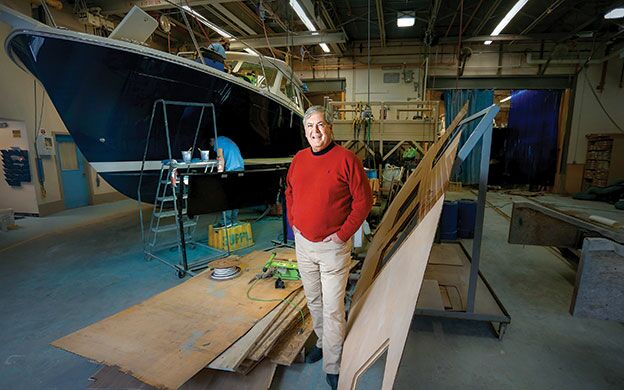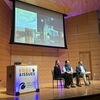Processing Your Payment
Please do not leave this page until complete. This can take a few moments.
- News
-
Editions
View Digital Editions
Biweekly Issues
- December 1, 2025
- Nov. 17, 2025
- November 03, 2025
- October 20, 2025
- October 6, 2025
- September 22, 2025
- + More
Special Editions
- Lists
- Viewpoints
-
Our Events
Event Info
Award Honorees
- Calendar
- Biz Marketplace
Boat business rebounds, but workforce is elusive
 Photo / Tim Greenway
Bentley Collins, vice president of marketing and sales at Sabre Yachts and Back Cove Yachts, at the Sabre manufacturing site in Raymond. Like many boatbuilders, Sabre and Back Cove have plenty of job openings.
Photo / Tim Greenway
Bentley Collins, vice president of marketing and sales at Sabre Yachts and Back Cove Yachts, at the Sabre manufacturing site in Raymond. Like many boatbuilders, Sabre and Back Cove have plenty of job openings.
At Sabre Yachts in Raymond, boatbuilding is going gangbusters, a situation largely attributed to the continuous development of new models that use the latest technologies such as poddrive propulsion systems and joystick controls that replace traditional inboard power systems.
“Those technologies are fascinating for customers,” says Bentley Collins, vice president of marketing at Sabre and its sister company, Back Cove Yachts in Rockland. Collins wears many hands in the industry, serving as president of the industry association Maine Built Boats and on the board of the Boat Manufacturers Division of the National Marine Manufacturers Association.
High customer demand should mean a larger workforce. Indeed, Sabre and Back Cove, like boatbuilders throughout Maine, have plenty of job openings.
But they are competing with other boatbuilders — and other industries — for a limited pool of qualified workers. At the same time boatbuilders, the construction industry and manufacturers are looking for young people to bring into the trades, young people are turning their back on traditional industries.
“All sorts of companies are hiring, so the number of available people is limited,” says Collins. “We've been challenged by that.”
“It's tough to find people,” agrees Drew Lyman, president of Lyman-Morse in Thomaston and a recently acquired service yard, Lyman-Morse at Wayfarer Marine in Camden. “What happens is, if all the yards are busy, there aren't a lot of people to hire.”
New products, new demand for workers
Sabre prides itself on its push to innovate and develop new products. That's what kept the company going through the recession. A significant drop in sales nearly cut the workforce in half, from a pre-recession peak of 130. The company strategically retained, among its core group of employees, its in-house design and engineering team.
“We went ahead and developed a new series of boats during the worst of times,” Collins says. “My philosophy has always been that, if you can develop new products in the worst of times, there is a group of buyers who will always buy new. Between 2008 and 2012, virtually every boat in our range was renewed, upgraded or replaced. So we ended up with a new group of products. And when the recession was truly over, that was our big market share gain.”
Along with designs of new models, ranging from 38 feet to 66 feet, sales exploded. Since their debut six years ago, Sabre has sold 47 of its Sabre 38 “salon express” boats and over 90 of the Sabre 48 model.
Customers are attracted to what's new.
“I compare this with a customer walking into a car showroom and seeing five- and six-year-old models on the floor,” he says. “I don't think anyone would say, 'Look, there's a 2008 Honda Civic. I think I'll buy it.' People like new technologies, they like new styles.”
Customer interest translated handily into increased employment. Today, total employment at Sabre and Back Cove is at 350. Half the workers are involved in either interior furniture construction or fiberglass fabrication. The remainder of workers include mechanics, electricians, varnishers, designers, engineers and managers.
But the two companies need more workers. At last count, Sabre had seven openings and Back Cove had a dozen. Disciplines range from fiberglass fabrication to woodworking and electrical to mechanical work.
And those happen to be the jobs most difficult to fill, builders in general agree. This is partly due to competition within the boatbuilding industry for the same pool of workers, and also to the growth of other industries, such as home construction, that parallels the success of the boatbuilding industry.
That means companies of all types are competing for the same people to work for them.
“This is not a problem unique to boatyards,” says Julie Rabinowitz, communications director for the Maine Department of Labor. “It's a problem in precision manufacturing, health care, IT and several other industries. But there's also a geographic component to boatyards, because they're usually on the coast. And there's a lot of competition for workers on the coast because seasonal work gives people more choices.”
Shrinking labor pool
In the past, people who signed onto boatbuilding often stuck with it. At Sabre, which was established in 1970, the average tenure is 15 years. Like other long-time boatbuilders in Maine, there's a good mix of age and gender, with an increasing presence of women on the production floor and long-time workers often acting as mentors.
“Older folks set a great example,” says Collins. “We recently celebrated the 30th year of one associate. He's shown up for work every day, year after year. He's a rock-solid employee. We have a lot of long-time associates, and they're involved in training other individuals.”
But at the same time older workers are retiring, new hires often aren't staying as long. Last year, about 25% of Back Cove's and 10% of Sabre Yacht's new hires left for other jobs.
Some employees decided boatbuilding wasn't right for them. In other cases, young people simply hadn't committed to a career or home base.
They walked away at a time when wages and benefits have become more competitive. At Sabre and Back Cove, benefits include a 401(k) plan and company match, subsidized health plan, education assistance and bonus programs, and opportunities for advancement, Collins says. The benefit package equates to about $8 an hour. Collins won't say what Sabre or Back Cove pay.
The most recent study, done in 2007 by the Maine Department of Labor, showed that annual wages at boatbuilders with 20 or fewer employees averaged $29,928; boatbuilders with more than 50 employees paid an average of $41,025.
Builders say it seems that young people just setting out on career paths aren't particularly interested in the trades, particularly compared with sectors such as technology and finance.
“Kids think about people on Wall Street or in the technology world, making a million bucks out of college,” says Lyman, who employs about 110 people in total at two sites, and is looking for more people in all aspects of the business. “It's hard to compete with that.”
Rabinowitz says there are other avenues to explore. For one thing, she says, displaced workers, such as those laid off from the paper mills, form a good-sized applicant pool.
“They've been working 10 or 20 years, they have excellent work histories, but their skill set doesn't exactly match what boatbuilders need,” she says. “But that's a very valuable worker even if you have to invest in training. They're trained in the culture of working and just need to be given experience.”
For potential workers of all ages and levels of experience, Rabinowitz says, it's incumbent on employers to maximize their visibility.
“Part of that is getting to high schools and to career and technical schools so that students know these opportunities exist. We can assist with some of that,” through pre-apprenticeship and job shadowing programs, for example, Rabinowitz says. “But if employers just stand in a field and say, 'I can't find any workers,' that doesn't help them. They have to reach out, and then we can assist them in raising their profile. Part of that is getting into the local high school or career and technical school and saying, 'Hey, did you know that, down that dirt road where you see the sign that says boatyard, it's not a yard with boats in it; it's a high-tech manufacturing company.'”
Manufacturing, she says, was once a highly visible enterprise, taking place, for example, in huge mills and integrated with multi-generational communities.
“Manufacturing today takes place in relatively nondescript steel buildings, outside of town in an industrial zone or down a nondescript road,” she says. “And what's going on in there is not visible to students. So it really is about outreach and education and letting people know what kind of work is going on and what kind of skill you need to get those jobs. And letting people know that, if you want to stay in your community, these jobs are here.”
Rabinowitz mentions that the DOL would like to hear from boatbuilders. “We currently do not have any industry or employer partnerships in boatbuilding. So if they call us that would be great. We could do a lot to help them.”
Read more
Mainebiz web partners

The Giving Guide
The Giving Guide helps nonprofits have the opportunity to showcase and differentiate their organizations so that businesses better understand how they can contribute to a nonprofit’s mission and work.
Learn More
Work for ME
Work for ME is a workforce development tool to help Maine’s employers target Maine’s emerging workforce. Work for ME highlights each industry, its impact on Maine’s economy, the jobs available to entry-level workers, the training and education needed to get a career started.
Learn More
Groundbreaking Maine
Whether you’re a developer, financer, architect, or industry enthusiast, Groundbreaking Maine is crafted to be your go-to source for valuable insights in Maine’s real estate and construction community.
Learn more-
The Giving Guide
The Giving Guide helps nonprofits have the opportunity to showcase and differentiate their organizations so that businesses better understand how they can contribute to a nonprofit’s mission and work.
-
Work for ME
Work for ME is a workforce development tool to help Maine’s employers target Maine’s emerging workforce. Work for ME highlights each industry, its impact on Maine’s economy, the jobs available to entry-level workers, the training and education needed to get a career started.
-
Groundbreaking Maine
Whether you’re a developer, financer, architect, or industry enthusiast, Groundbreaking Maine is crafted to be your go-to source for valuable insights in Maine’s real estate and construction community.
ABOUT
NEW ENGLAND BUSINESS MEDIA SITES
No articles left
Get access now
In order to use this feature, we need some information from you. You can also login or register for a free account.
By clicking submit you are agreeing to our cookie usage and Privacy Policy
Already have an account? Login
Already have an account? Login
Want to create an account? Register
Get access now
In order to use this feature, we need some information from you. You can also login or register for a free account.
By clicking submit you are agreeing to our cookie usage and Privacy Policy
Already have an account? Login
Already have an account? Login
Want to create an account? Register







Comments